As an Amazon Associate I earn from qualifying purchases.
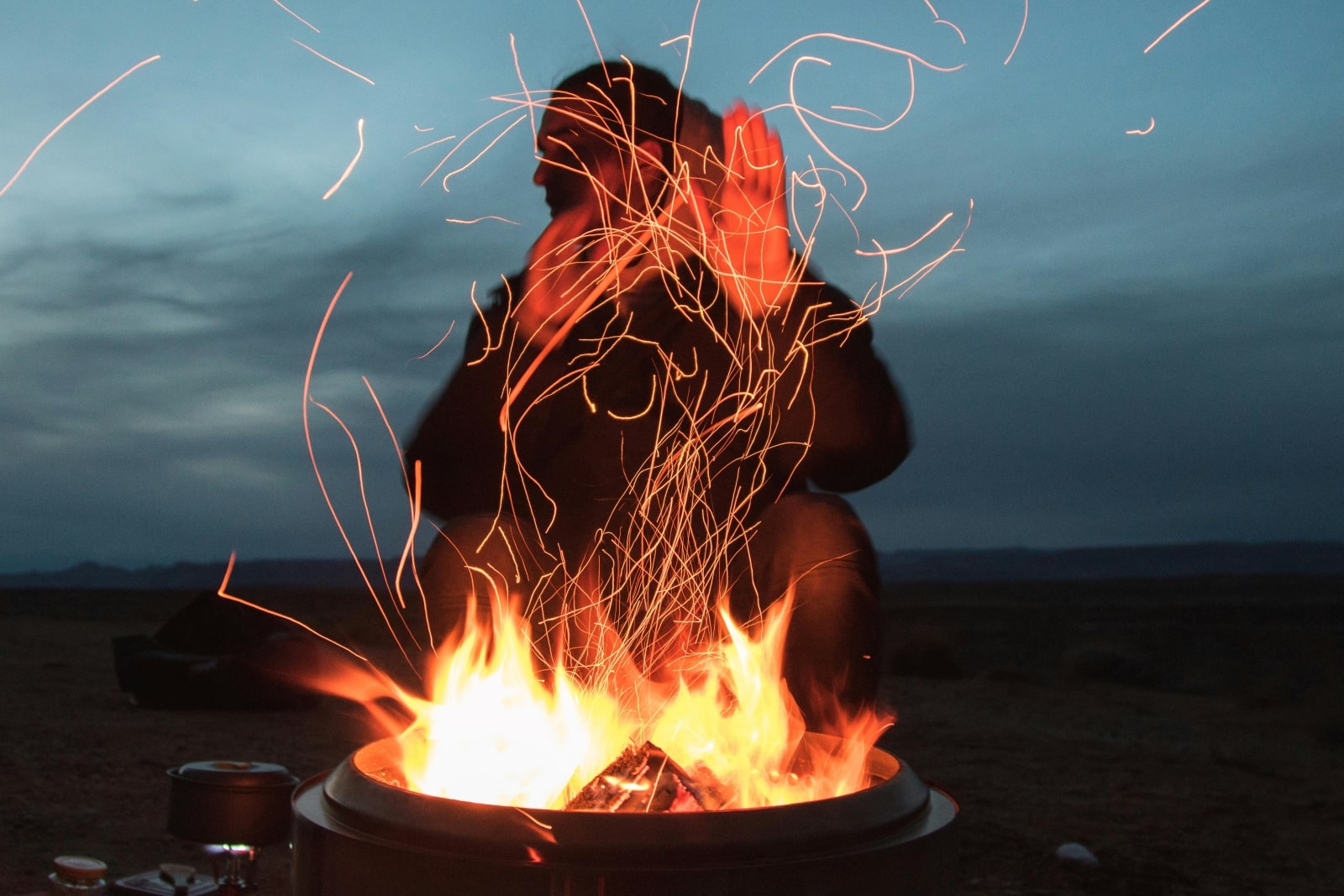
Camping offers a chance to connect with nature, but cold weather can quickly turn the experience uncomfortable or even unsafe. Knowing how to stay warm camping is essential for ensuring both safety and enjoyment, especially during chilly nights or winter excursions.
In this article, we’ll dive into practical tips, gear recommendations, and strategies to help you stay warm while embracing the great outdoors.
Preparation: Plan Ahead for Warmth
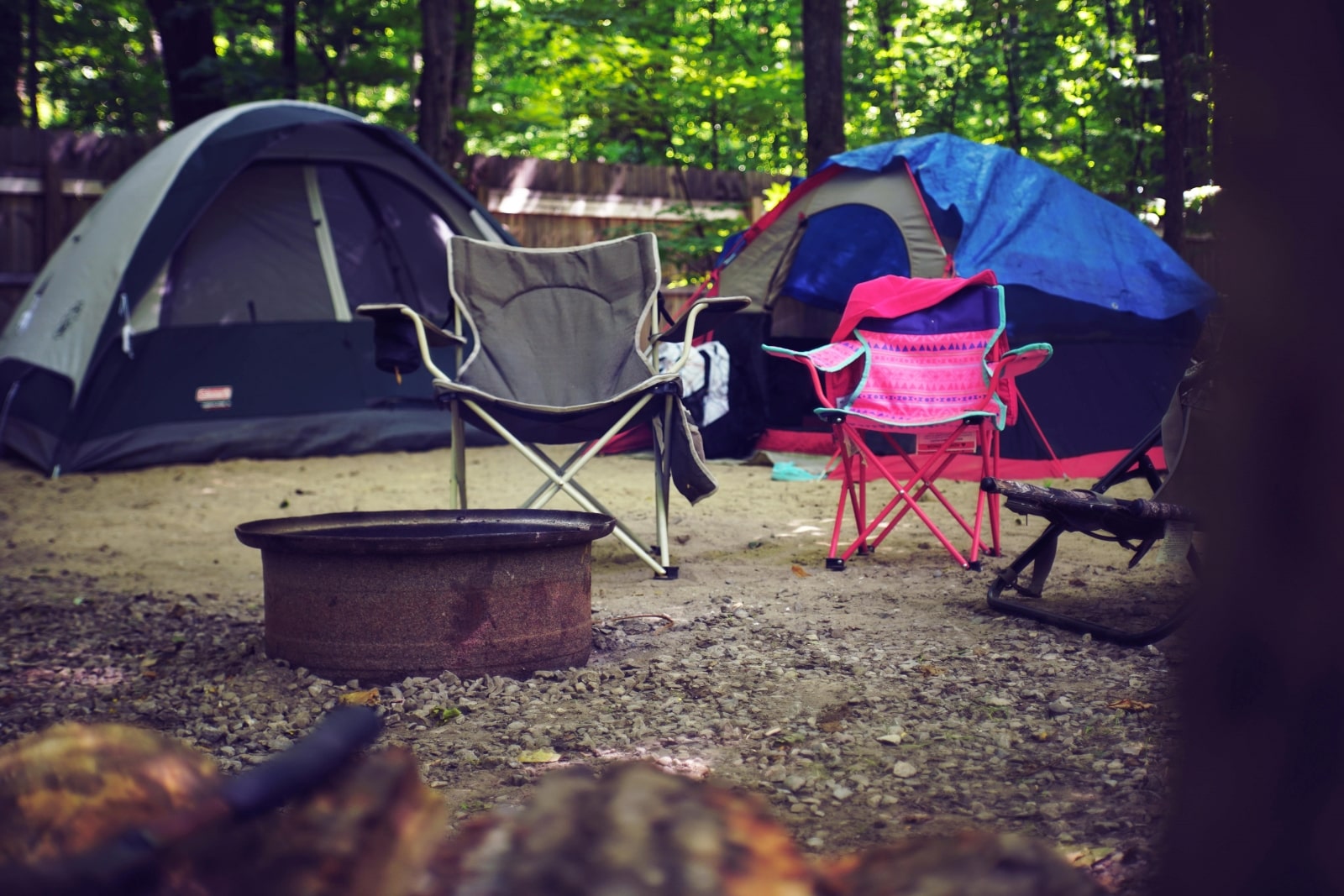
Preparation is the key to staying warm and comfortable during your camping trip. A little forethought ensures you’re ready for whatever nature throws your way, making your outdoor experience safer and more enjoyable.
Knowing how to stay warm camping starts long before you leave home, with careful planning that includes weather research, gear selection, and campsite evaluation.
Research the Weather and Terrain
Begin by studying the weather forecast for your destination. Look beyond temperature to factors like wind speed, humidity, and precipitation. Cold air feels harsher with high winds, while damp conditions can sap warmth from your body.
Consider seasonal patterns, and plan for nighttime temperatures, which often plunge far below daytime highs. Checking these details helps you pack the right clothing and gear for how to stay warm camping, even in unpredictable conditions.
The terrain also matters. Mountainous areas can see rapid weather changes, while valleys often trap colder air. Familiarize yourself with the landscape to anticipate the microclimates you might encounter. This knowledge helps you choose a campsite that maximizes warmth and comfort.
Pack Strategically for Warmth
Packing the right gear is essential for staying warm. Start with layered clothing to manage body temperature effectively. Select a moisture-wicking base layer, such as synthetic materials or merino wool, to keep sweat off your skin.
Your middle insulating layer should trap heat, so opt for down, fleece, or a synthetic equivalent. The outer layer, a waterproof and windproof shell, shields you from the elements. This system is a cornerstone of how to stay warm camping, as it adapts to changing conditions.
Don’t overlook smaller items that make a big difference. Insulated gloves and hats retain heat in extremities, while a quality scarf protects your neck from wind chill. Thermal socks and durable boots keep your feet warm and dry. Always carry a backup set of clothing in case of unexpected weather or mishaps.
Choose and Prepare the Campsite Carefully
The location of your campsite directly affects how to stay warm camping. Scout for areas sheltered from wind, such as near tree lines, rock formations, or hills. Avoid valleys or depressions where cold air collects overnight. If possible, orient your tent’s entrance away from prevailing winds to reduce drafts.
Ground preparation is equally important. Clear away snow, ice, or debris before pitching your tent. Adding a layer of insulating material, like a tarp or foam, between your tent and the ground prevents heat loss. Even a simple precaution, like laying down dry leaves or pine needles, can help retain warmth.
Test and Organize Your Gear
Before heading out, test all your equipment to ensure it works as intended. Set up your tent, check zippers, and verify that your sleeping bag matches the expected temperatures. Confirm that portable heaters, lanterns, or stoves are in good working order.
Organization also plays a role in staying warm. Keep essential items, such as gloves, hats, and warmers, easily accessible. During cold nights, knowing where to find what you need saves time and prevents heat loss while searching in the dark.
By combining research, thoughtful packing, and campsite selection, you’ll build a solid foundation for warmth and comfort. Mastering these steps ensures you’re fully prepared for how to stay warm camping, no matter the challenges you face.
Food and Hydration: Fuel Your Warmth
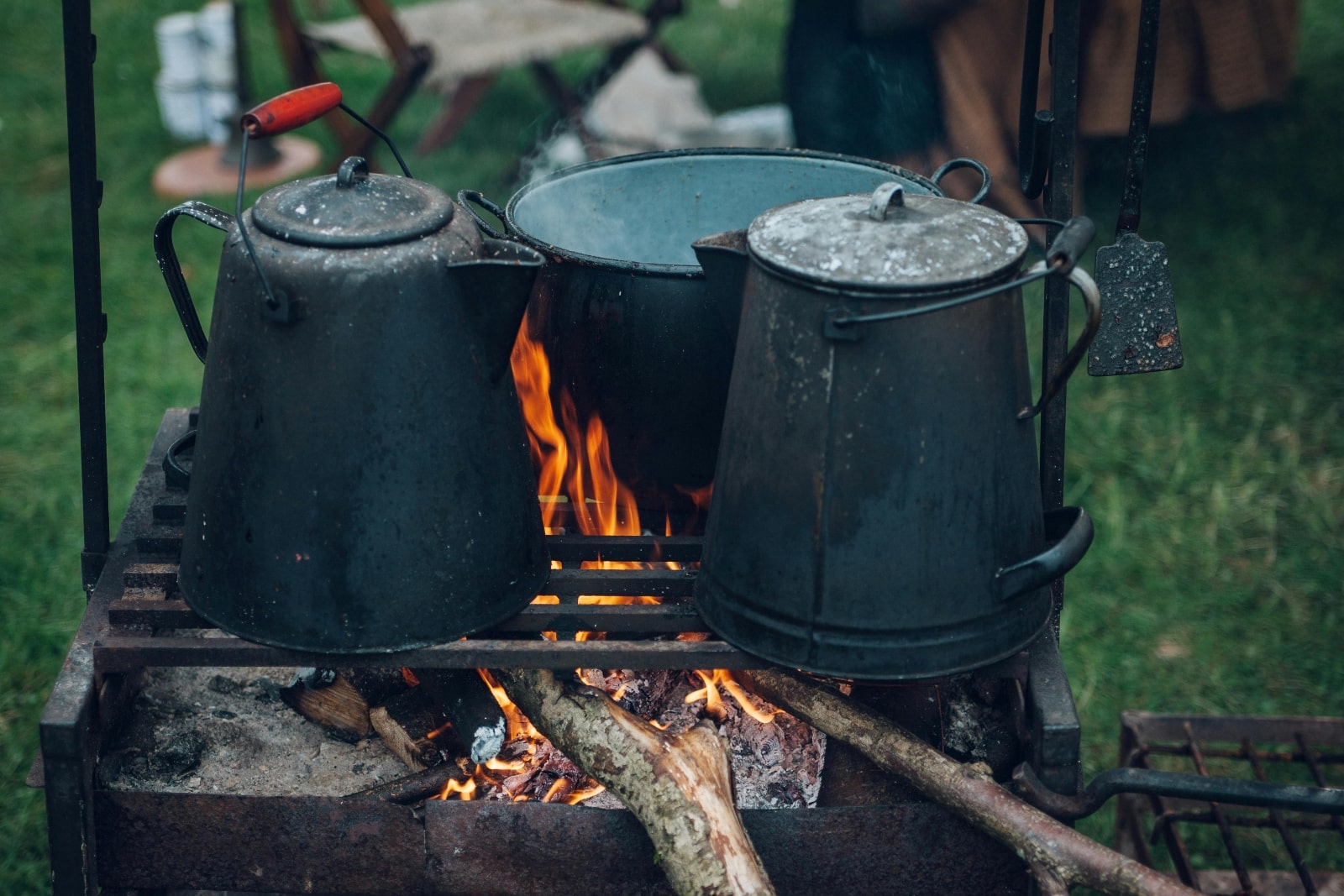
What you eat and drink while camping plays a crucial role in maintaining body heat. Proper nourishment and hydration give your body the energy it needs to stay warm and active in cold conditions. Learning how to stay warm camping goes beyond layering clothes and includes fueling your body with the right types of sustenance.
Prioritize High-Energy Meals
To generate heat, your body burns calories, especially in cold environments. Prioritize high-calorie, nutrient-dense foods that provide long-lasting energy. Meals rich in carbohydrates, fats, and proteins act as your body’s fuel.
Carbohydrates, like rice or pasta, give you quick energy, while fats, such as those found in nuts or cheese, offer slow-burning, sustained warmth.
During the day, snack regularly to keep your metabolism active. Trail mix, dried fruit, granola bars, and jerky are excellent portable options that provide balanced energy. For dinner, consider a hearty stew or chili packed with proteins and healthy fats to help you recover from the day and prepare for the night’s cold.
Cook Hot Meals Whenever Possible
Hot meals warm you from the inside and boost morale in cold weather. Breakfasts such as oatmeal or scrambled eggs not only start your day right but also help your body retain warmth. At dinner, soups and hot casseroles provide hydration and calories in one satisfying dish.
Carrying lightweight, easy-to-cook options makes meal preparation efficient. Instant soups, powdered mashed potatoes, or freeze-dried meals are convenient for camping while offering warmth and energy.
Drink Warm Beverages
Hot beverages play a dual role in providing warmth and hydration. With the help of a trusty coffee maker or camping kettle, you can easily prepare comforting drinks like hot tea, coffee, cocoa, or broth to warm your core and stay hydrated. Herbal teas like ginger or chamomile, brewed to perfection, are soothing and promote circulation. Broth-based soups, rich in sodium and nutrients, can also be conveniently warmed, helping to replenish electrolytes lost during activity.
Avoid alcohol and caffeine close to bedtime. While they may feel warming initially, alcohol causes heat loss, and caffeine can interfere with your sleep, making it harder to stay warm overnight.
Stay Hydrated with Care
Proper hydration is essential, even in cold weather. Dehydration lowers your body’s ability to produce heat, making it harder to stay warm camping. Carry an insulated water bottle to keep liquids from freezing, and drink regularly, even if you don’t feel thirsty. Cold weather can suppress thirst, so be mindful of your intake.
Warm water infused with lemon or honey can encourage hydration while providing subtle warmth. Avoid sugary drinks that might give short bursts of energy but lead to crashes later.
Eat Before Sleeping
One lesser-known trick to staying warm at night is eating a small snack before bed. This provides your body with fuel to burn while you sleep. Choose calorie-dense options like nuts, peanut butter, or a granola bar. By maintaining an active metabolism, your body generates heat that helps you stay warm camping.
Proper food and hydration strategies are essential for cold-weather camping. They ensure you have the energy and hydration needed to combat the chill, making your outdoor adventure both enjoyable and warm.
Sleeping Arrangements: Optimize for Warmth
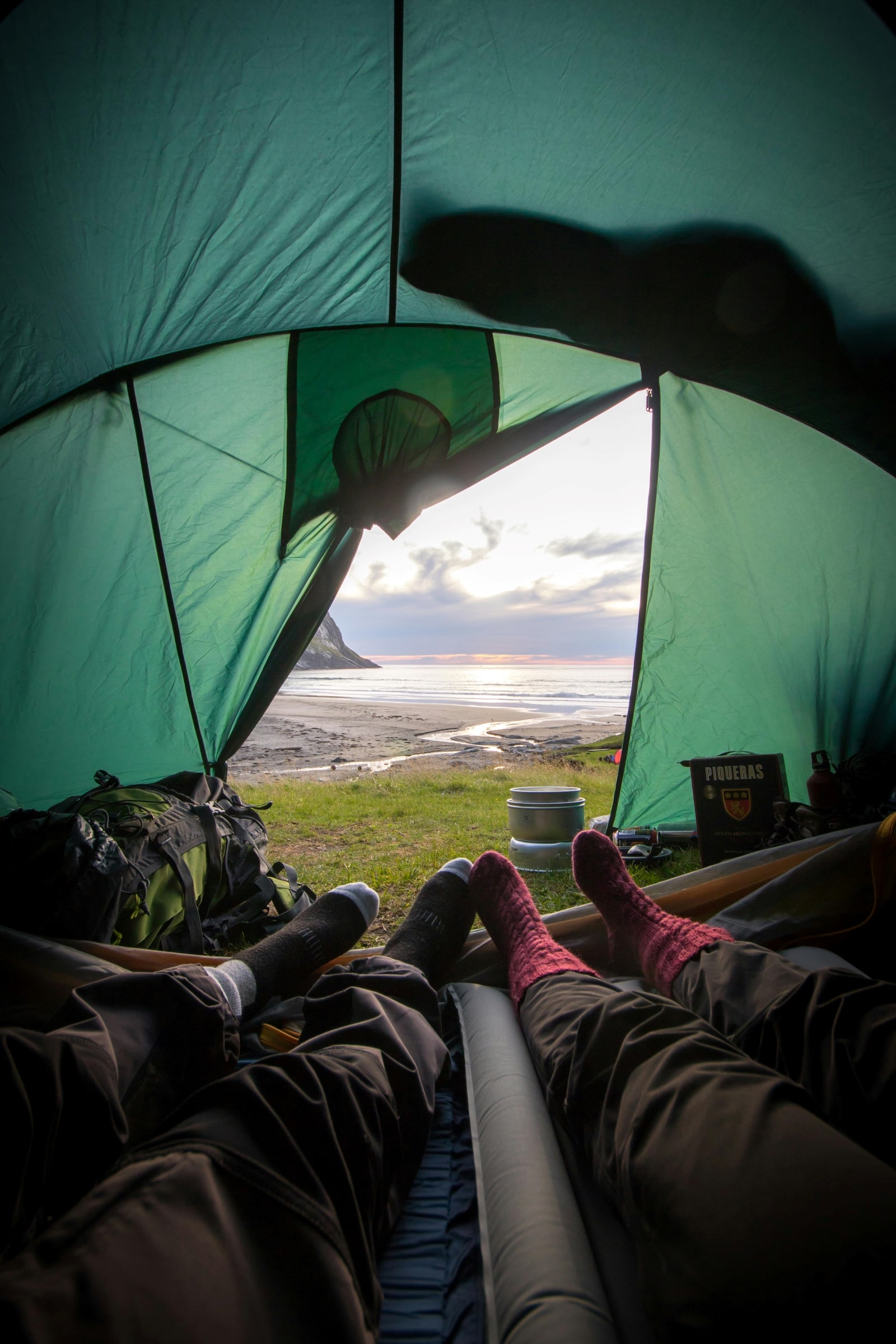
Ensuring your sleeping setup is designed for warmth is one of the most important aspects of staying comfortable during a camping trip. When you understand how to stay warm camping, the right combination of sleeping bag, pad, and nighttime accessories can turn a potentially freezing night into a cozy and restful experience.
Select a High-Quality Sleeping Bag
Choosing the right sleeping bag is critical for staying warm. Opt for a sleeping bag that matches the expected temperatures of your trip, or one rated slightly lower to account for unexpected cold snaps.
Down sleeping bags are lightweight and highly effective at retaining heat but require extra care to keep them dry. Synthetic options, while slightly heavier, perform better in damp conditions and dry faster.
When selecting a bag, consider its shape. Mummy-style sleeping bags hug your body closely, minimizing air pockets where heat can escape.
This design enhances how to stay warm camping by maximizing thermal efficiency. If you’re camping in extreme cold, add a sleeping bag liner to boost warmth without adding much bulk.
Use an Insulated Sleeping Pad
The ground beneath your tent can sap warmth from your body, no matter how insulated your bag is. Sleeping pads act as barriers, preventing heat loss and adding an essential layer of comfort.
Look for pads with a high R-value, which measures their thermal resistance. Combining a closed-cell foam pad with an inflatable pad can further enhance insulation while offering added comfort.
Prepare Your Sleeping Area
Preparation extends beyond gear. Lay down an extra tarp or footprint beneath your tent to block moisture and cold from seeping through. Inside the tent, consider adding a reflective emergency blanket under your sleeping pad to bounce heat back toward your body.
Arrange your tent to maximize warmth. Keep items you might need overnight, such as gloves or water bottles, close at hand so you can avoid losing heat by rummaging in the cold. Insulating your tent’s walls with blankets or specialized tent liners can also make a noticeable difference.
Keep Yourself Warm Before Bed
How you prepare your body for rest significantly impacts how to stay warm camping. Before getting into your sleeping bag, change into dry, warm clothes. Avoid wearing clothing that is damp from sweat or activities.
Perform light physical exercises, like jumping jacks or brisk walking, to generate heat, but don’t overdo it to the point of sweating.
Slip a hot water bottle into your sleeping bag before crawling in, placing it near your feet or core. This simple step can provide hours of additional warmth. Alternatively, use chemical hand warmers for a similar effect.
Nighttime Comfort Strategies
To prevent losing heat while you sleep, wear a thermal hat and socks. A beanie traps heat that would otherwise escape through your head, while thick, dry socks protect your feet from the chill. Some campers even opt to sleep with gloves for added warmth.
If you find yourself struggling with cold spots, adjust your sleeping bag’s hood and drawstrings to seal in warmth. For those using sleeping bags without hoods, wrapping a scarf or buff around your head and neck can offer extra insulation.
With a well-thought-out sleeping arrangement and proactive strategies, you can ensure a warm, restful night. These small adjustments and the right gear choices transform how to stay warm camping from a challenge into second nature.
Campfire Tips: Maximize Heat Efficiency
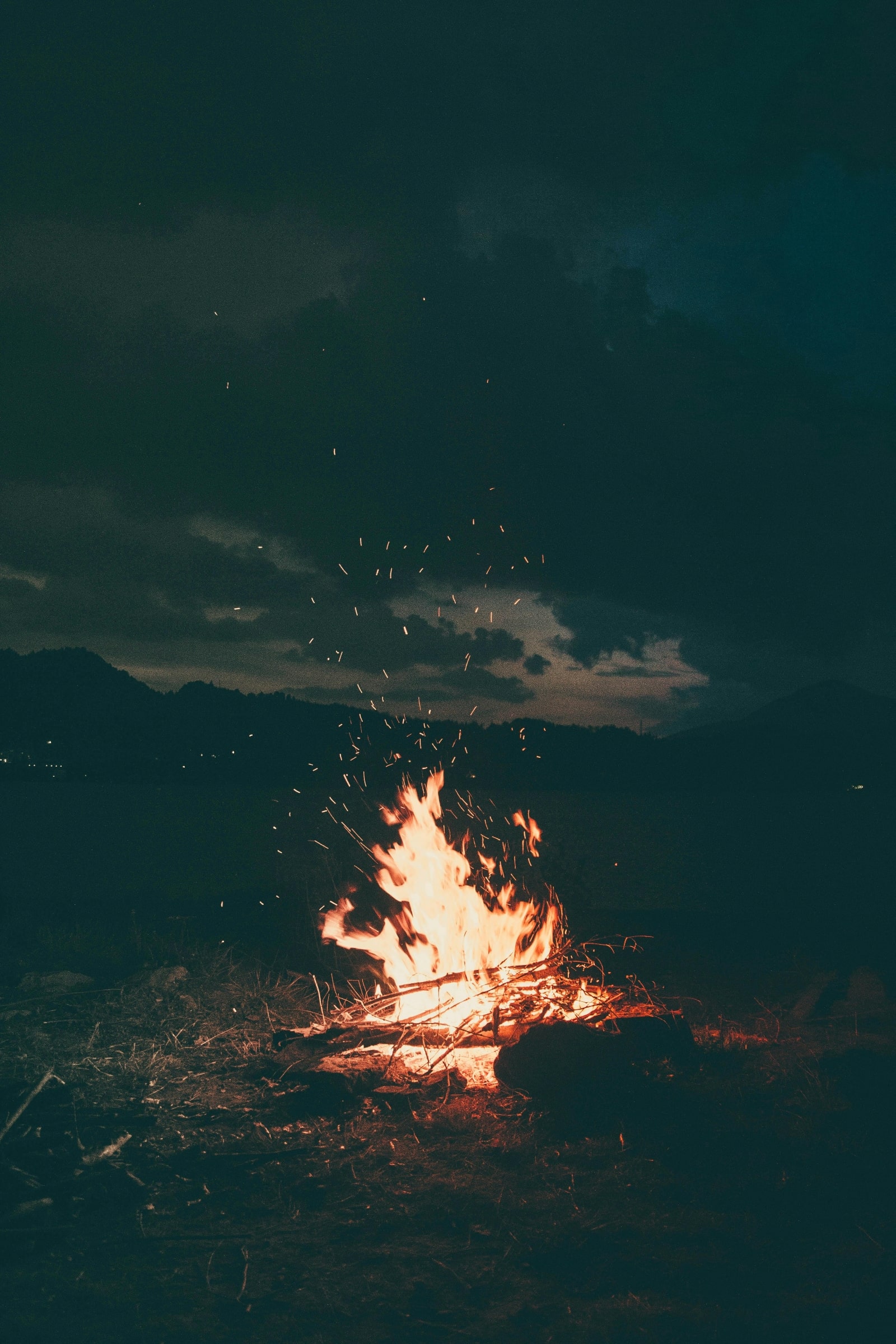
The campfire is a quintessential element of any camping trip, providing warmth, light, and a cozy gathering spot. When used strategically, it becomes a critical tool for staying warm in colder conditions. Understanding how to stay warm camping often involves learning to build, maintain, and utilize a campfire effectively.
Build a Reliable Fire
A properly built fire is the foundation of heat efficiency. Start by selecting dry wood, as wet or damp logs reduce heat output and produce excess smoke. Gather three types of fuel: tinder (dry leaves, twigs, or paper), kindling (small sticks), and larger logs.
Use the teepee or log cabin structure to ensure optimal airflow and steady burning. These methods encourage consistent flames, which are essential for maintaining warmth.
Once your fire is going, gradually add larger logs to sustain it. Dense hardwoods, such as oak or maple, burn longer and hotter compared to softwoods like pine. Understanding the type of wood available can make a significant difference in how to stay warm camping with a fire.
Position Yourself for Maximum Warmth
Where you sit around the fire affects how much heat you absorb. Position yourself upwind, as the breeze will carry warmth toward you rather than away. To amplify the fire’s heat, use reflective surfaces like aluminum foil blankets or large flat rocks. Place these behind the fire to redirect heat toward your seating area.
If the fire’s heat doesn’t reach your entire body, consider using a low chair or sitting on a foam pad. Insulating your seating area keeps you from losing heat to the cold ground, enhancing the effectiveness of the fire.
Utilize the Fire to Preheat Gear
One of the most practical uses of a campfire is preheating gear. Before heading to bed, place items like gloves, socks, or even a water bottle near the fire. Be cautious to avoid direct contact with flames or excessive heat. Once warmed, tuck these items into your sleeping bag for sustained warmth throughout the night.
Hot rocks are another clever way to retain heat. Heat a few fist-sized stones by placing them near the fire. Wrap the rocks in cloth or socks, then place them inside your sleeping bag or at the foot of your tent.
Maintain Fire Safety
While a fire is vital for warmth, safety must remain a priority. Never leave the campfire unattended, and keep a bucket of water or sand nearby to extinguish it if necessary. Build your fire on designated fire pits or bare ground to reduce the risk of spreading flames. Proper fire management not only keeps you warm but ensures a safe camping experience.
Extinguish the Fire Properly
At the end of the night, thoroughly douse the fire with water to ensure all embers are extinguished. Stir the ashes to expose any hidden heat, then add more water if needed. A cold, extinguished fire reduces the risk of accidents and leaves the site ready for future campers.
Mastering campfire techniques transforms how to stay warm camping, making the fire an efficient source of heat and comfort. With proper care and attention, it becomes more than just a survival tool—it’s the heart of a cozy campsite experience.
Essential Gear for Staying Warm
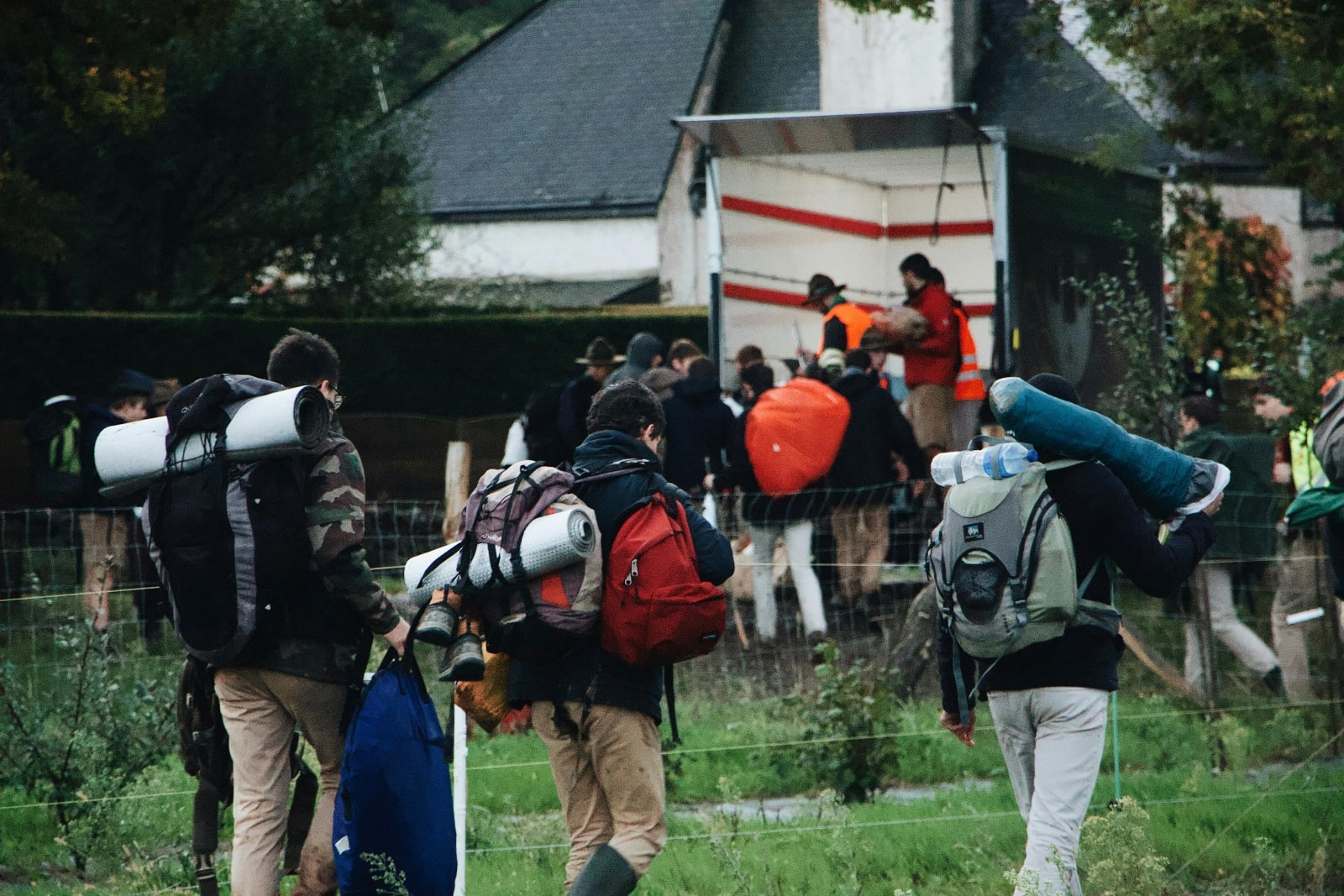
Having the right gear is a critical component of staying warm while camping. The equipment you bring not only enhances comfort but also provides a safety net against the challenges of cold weather. When you know how to stay warm camping, you’re better equipped to make strategic gear choices that keep you cozy and protected.
Portable Heaters for Immediate Warmth
Portable heaters are an excellent way to boost warmth in your tent or campsite. Propane heaters provide powerful, consistent heat and are perfect for stationary use, like sitting around camp or preparing for bed. For eco-friendly or smaller setups, consider rechargeable electric heaters. Ensure your heater is rated for indoor or tent use and always follow safety precautions, such as maintaining ventilation to avoid carbon monoxide buildup.
If a heater isn’t an option, you can still achieve focused warmth with reusable hand warmers or heating pads. These compact devices offer targeted relief to keep hands and pockets warm, especially during extended outdoor activities.
Invest in Quality Clothing and Accessories
Layering clothing remains one of the most effective methods for maintaining warmth. Thermal base layers wick moisture and regulate your body temperature, while mid-layers like fleece or down insulate you against the cold. A reliable outer layer, such as a waterproof and windproof jacket, shields you from harsh weather.
Accessories play an equally crucial role in how to stay warm camping. Insulated gloves, a thermal beanie, and a scarf ensure extremities retain heat. High-quality wool or synthetic socks paired with waterproof boots keep feet dry and warm.
Four-Season Shelters and Insulation
If you’re camping in freezing conditions, a four-season tent designed for cold weather is indispensable. These tents have thicker materials, reinforced poles, and features like snow flaps to prevent heat loss. To further insulate your shelter, use reflective blankets or specialized tent liners that trap and redirect warmth back toward you.
For ground insulation, a durable tarp under the tent and foam mats inside provide an added layer of protection against cold surfaces. Insulating yourself from the ground is one of the most overlooked yet effective ways to retain heat.
Reliable Sleeping Gear
Sleeping bags rated for sub-freezing temperatures are essential for cold-weather camping. Look for bags filled with down or synthetic insulation, and consider adding a liner to boost their warmth rating. Complement your sleeping bag with a high-R-value sleeping pad to reduce heat loss through the ground.
A bivvy sack can also increase warmth by trapping body heat while acting as a wind barrier. These lightweight and compact options are ideal for those seeking additional insulation.
Lighting and Fire Tools
Efficient lighting and fire-starting tools support your ability to stay warm. Headlamps and lanterns allow you to navigate and set up camp after dark without struggling in the cold. A reliable fire starter, such as waterproof matches or a ferrocerium rod, ensures you can quickly build a fire when temperatures drop.
Having the right gear tailored to your camping environment is fundamental to how to stay warm camping. Each item plays a role in building a safe, comfortable, and enjoyable experience. Thoughtful preparation and investment in quality gear allow you to embrace the cold with confidence and warmth.
Strategies for Nighttime Warmth
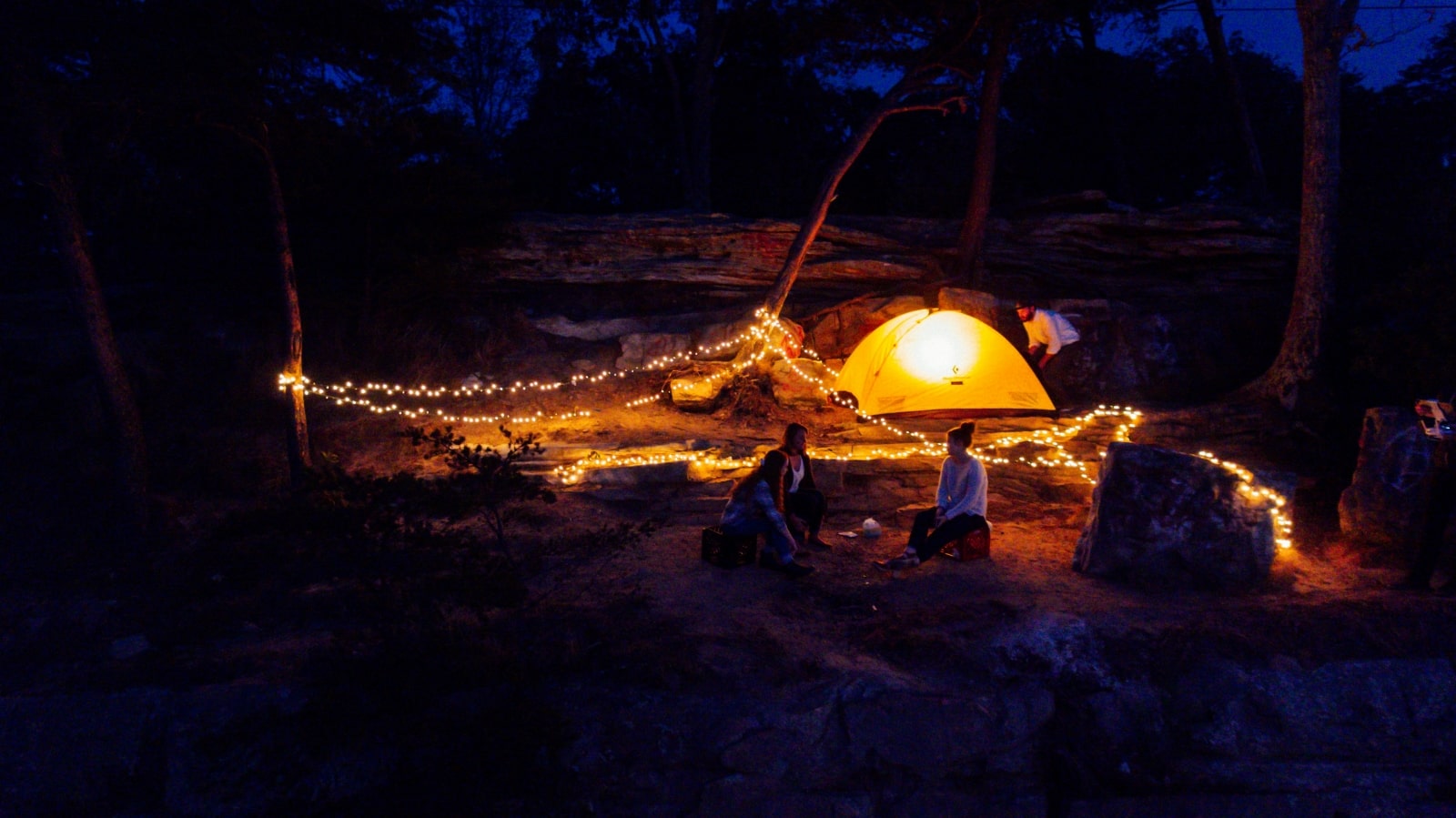
Keeping warm through the night is essential for a comfortable and safe camping experience. Nighttime temperatures often drop significantly, and the cold can disrupt sleep or even pose risks if not properly managed. Learning how to stay warm camping at night involves layering techniques, strategic placement of heat sources, and maintaining a warm, insulated environment.
Dress for Bed Appropriately
What you wear to bed can greatly impact your nighttime warmth. Opt for thermal or moisture-wicking base layers to regulate body heat and avoid sweat accumulation. Avoid wearing the clothes you hiked in, as even slightly damp clothing can steal warmth from your body. Fresh, dry socks and a thermal hat can make a huge difference in retaining heat during the night.
If you find yourself still feeling cold, consider adding an extra fleece layer or wrapping a scarf around your neck. Layering strategically is one of the simplest ways to enhance how to stay warm camping overnight.
Heat Your Sleeping Space Before Bed
Preheating your sleeping space creates a cozy environment before you climb in for the night. Fill a metal or heat-resistant water bottle with hot water and tuck it into your sleeping bag near your feet. This simple trick provides warmth for several hours. Alternatively, use reusable hand warmers placed near your core or hands for added heat.
Another effective strategy is to sit by the fire shortly before heading to bed. Warming up your body before settling in makes it easier to maintain a consistent temperature throughout the night.
Seal and Insulate Your Sleeping Bag
Your sleeping bag plays a central role in nighttime warmth. Seal it tightly by using the drawstrings on the hood and zipper to minimize drafts. If your sleeping bag lacks sufficient insulation, add a sleeping bag liner or use a bivvy sack to trap additional heat.
Pay attention to your sleeping bag’s placement within the tent. Avoid areas where cold air might pool, such as near tent doors. Insulating the ground beneath you with foam pads or an extra blanket prevents heat loss to the cold ground, which is a common source of nighttime discomfort.
Keep Moving Without Sweating
Light movement before bed, such as stretching or a brisk walk, can increase circulation and generate heat. Be cautious not to overexert yourself, as sweating can dampen clothes and reduce your body’s ability to retain warmth. Finding the balance between warming up and staying dry is key to mastering how to stay warm camping at night.
Reduce Heat Loss Inside the Tent
Tents can lose heat quickly, especially on cold nights. Minimize this by using reflective emergency blankets on the walls or ceiling to reflect heat back inside. If the tent is large, hang a makeshift curtain or divider to create a smaller, cozier space that traps warmth more effectively.
Keep the tent well-ventilated to prevent condensation, as moisture buildup inside the tent can make it feel colder. Crack a small vent or door flap to allow for air exchange without letting in drafts.
Stay Hydrated but Avoid Cold Drinks
Drinking warm beverages before bed helps maintain your core temperature. Herbal tea from a camping kettle or warm water with honey can provide gentle hydration and a soothing effect. Avoid alcohol or icy drinks, as they can lower your body temperature. Proper hydration ensures your body’s systems function optimally, which is crucial for generating heat.
Address Nighttime Emergencies Promptly
If you wake up feeling cold, don’t ignore it. Adjust your layers, reheat a water bottle, or eat a quick snack to replenish energy. These small adjustments can quickly restore comfort and prevent deeper cold from setting in.
Nighttime warmth is the result of thoughtful preparation and responsive actions. By implementing these strategies, you can ensure a comfortable and restful sleep, mastering the art of how to stay warm camping in any season.
Overcoming Common Cold-Weather Challenges
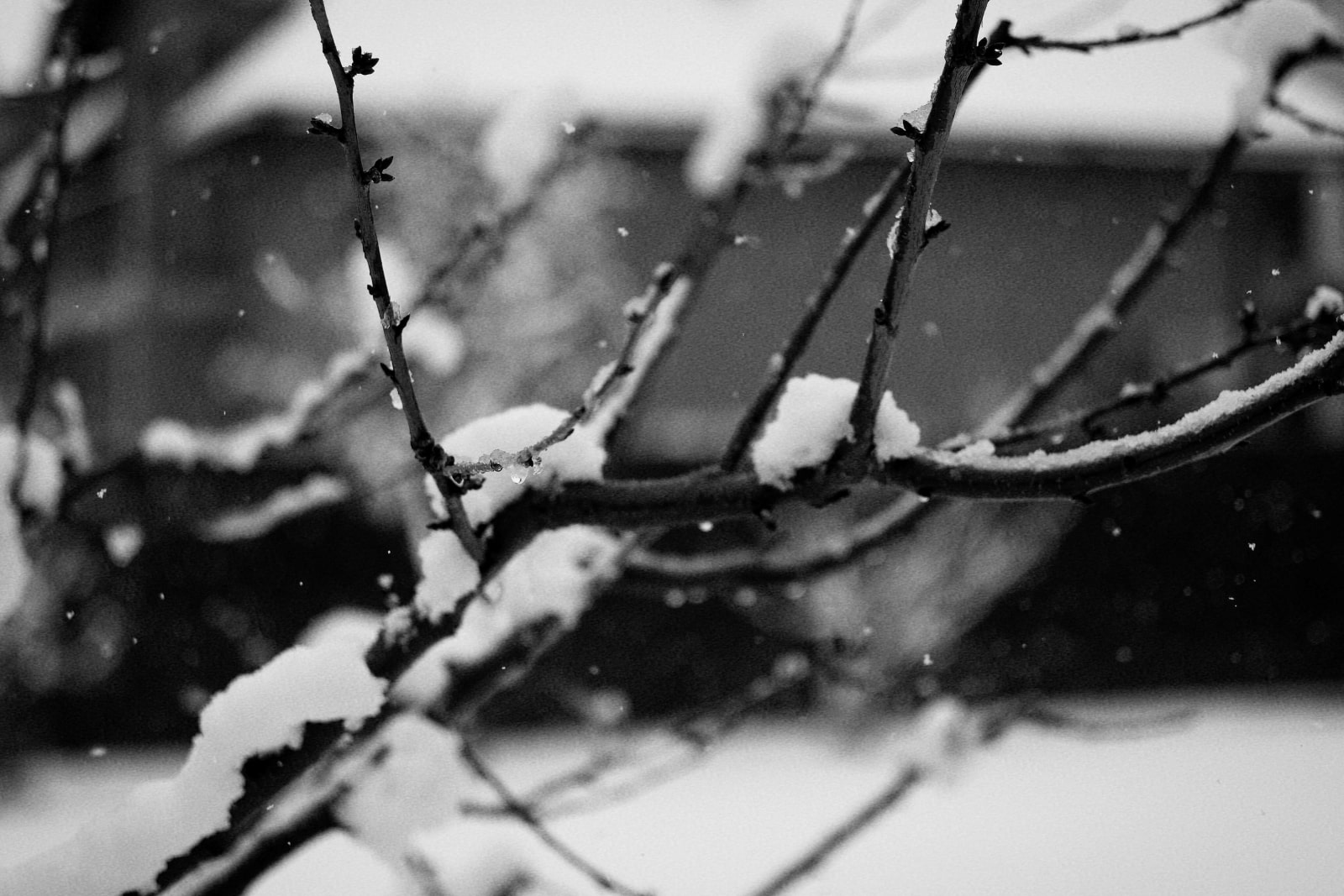
Camping in cold weather often brings unique challenges that can test your preparation and resolve. However, by anticipating potential issues and implementing effective solutions, you can enjoy your adventure while staying comfortable and safe. Learning how to stay warm camping involves addressing these obstacles with confidence and creativity.
Managing Wet Conditions
Wet conditions can quickly undermine your efforts to stay warm. Moisture not only makes clothing and gear less effective but also saps body heat. To combat this, prioritize waterproof and water-resistant gear, including your tent, outerwear, and boots. Setting up camp on elevated ground prevents water from pooling around your tent during rain or snow.
If your clothing or gear gets wet, dry it as quickly as possible. Hang damp items near a campfire, but maintain a safe distance to prevent damage. For smaller items, such as gloves or socks, tuck them into your sleeping bag overnight. The heat from your body will help remove moisture, making them usable the next day.
Fighting Wind Chill
Strong winds amplify the cold by stripping away the insulating layer of warmth around your body. To minimize wind exposure, choose a campsite sheltered by natural barriers like trees, rocks, or hills. Position your tent’s entrance away from prevailing winds to reduce drafts.
Wearing windproof clothing is another effective strategy. A durable outer shell with wind-blocking properties keeps cold air from penetrating your layers. For how to stay warm camping in windy conditions, ensure every exposed area is covered with protective clothing, including gloves and a hat.
Staying Warm During Snowfall
Camping in snow presents unique challenges but also opportunities for creative solutions. Snow insulates the ground, but direct contact with it can lead to rapid heat loss. Use a thick insulating layer beneath your tent, such as foam pads or an additional tarp, to prevent cold transfer.
Building a snow wall around your campsite can reduce wind impact and create a more comfortable environment. When preparing meals, melting snow for water can be efficient, but boil it thoroughly to eliminate impurities and retain warmth in your drink.
Avoiding Fatigue and Cold-Weather Exhaustion
Cold weather can drain your energy faster than you expect. To combat fatigue, pace your activities and prioritize rest. Consuming calorie-dense snacks and staying hydrated are vital for maintaining energy levels. Remember that knowing how to stay warm camping includes recognizing when to take breaks to recover.
Layering appropriately while being active prevents overheating, which can lead to sweating. Sweat dampens clothing and increases your vulnerability to cold. Adjust layers frequently to match your level of exertion.
Dealing with Frozen Gear
Frozen gear is a common issue in subzero conditions. Prevent this by storing critical items, like water bottles and boots, inside your tent or sleeping bag overnight. Insulating your gear with spare clothing or placing it near a heat source can also keep it usable.
If your tent zippers freeze, gently warm them with your hands or a reusable hand warmer before attempting to open them. For frozen water, use insulated bottles and store them upside down so any freezing occurs at the bottom, leaving the top accessible for drinking.
Addressing Nighttime Temperature Drops
Nighttime temperatures often plummet, making it the coldest and most challenging part of your camping experience. To counteract this, eat a calorie-rich snack before bed to fuel your body. Use all available insulation in your tent, including extra blankets or clothing, to seal in heat.
Keep a hot water bottle or warming device close by to combat sudden chills. Mastering how to stay warm camping during nighttime extremes ensures a restful sleep and prepares you for the next day’s activities.
By understanding and overcoming these common cold-weather challenges, you can focus on enjoying the adventure instead of merely enduring the elements. Proper preparation and quick thinking transform obstacles into manageable moments, making your camping trip a memorable and comfortable experience.
Staying Warm While Active
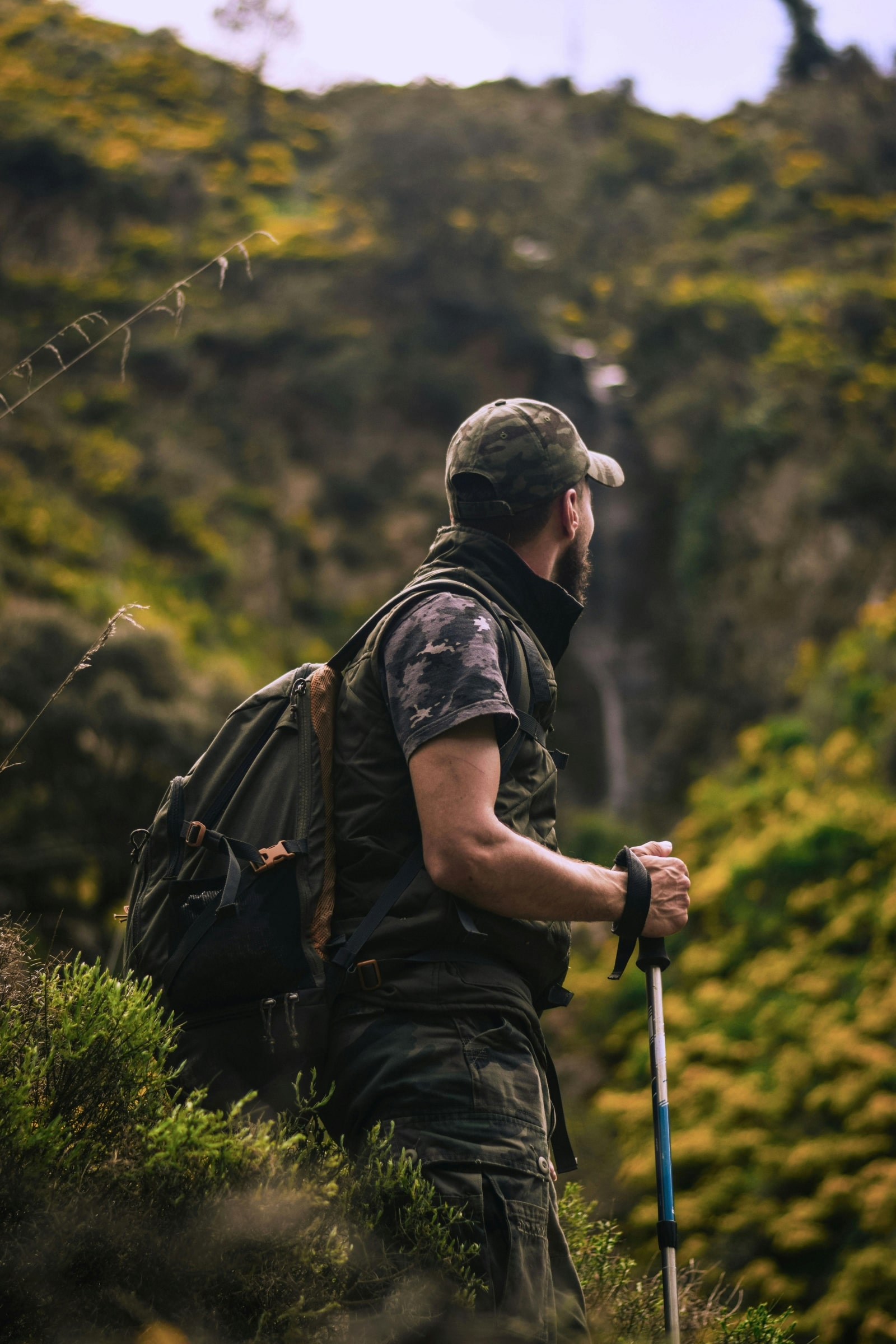
Remaining warm during physical activity in cold weather is a balancing act. Overexertion can lead to sweating, which cools your body when it evaporates. On the other hand, inactivity causes heat loss. Learning how to stay warm camping while staying active involves smart pacing, strategic clothing choices, and efficient energy use.
Dress for Dynamic Activities
Layering is key to maintaining a comfortable body temperature while active. Start with a moisture-wicking base layer to keep sweat off your skin. Add an insulating mid-layer, such as fleece, to trap heat. Finally, top it off with a breathable outer shell that blocks wind and repels water. The outer shell should have zippers or vents, allowing you to release excess heat without fully removing layers.
Accessories like gloves and hats are equally important. Choose gloves with removable liners so you can adjust for changing temperatures. A lightweight beanie or headband can prevent heat loss from your head while allowing flexibility.
Adjust Layers During Activity
As you move, your body generates heat. To avoid overheating, adjust your layers proactively. Open jacket vents, remove gloves, or take off your mid-layer as needed. When you pause for a break, replace removed layers quickly to prevent cooling down too much.
Understanding how to stay warm camping during outdoor activities also means paying attention to how your body feels. If you start to sweat, slow down and adjust your clothing. Damp clothing from sweat cools quickly, making it harder to maintain warmth when you stop moving.
Stay Dry in All Conditions
Staying dry is critical for maintaining warmth during activity. Wet clothing conducts heat away from your body, even when you’re exerting yourself. Wear waterproof boots and gaiters to keep snow, slush, or rain from soaking your feet. Opt for synthetic or wool fabrics that dry quickly and retain heat even when damp.
If you’re planning high-intensity activities like hiking or chopping wood, carry extra clothing to change into afterward. Having dry layers ready ensures you stay warm once the activity is over.
Maintain a Steady Energy Flow
Cold weather burns calories faster, especially during activity. Keep your energy levels high by eating small, frequent snacks. Foods rich in carbohydrates and fats provide quick energy and lasting fuel. Hydration is equally important, as dehydration reduces your ability to regulate body temperature.
Drink warm fluids like tea or broth to replenish fluids and add heat to your core. Avoid cold drinks, as they force your body to expend extra energy warming them to body temperature.
Use Active Movement to Generate Warmth
Simple movements, such as swinging your arms, jogging in place, or performing squats, can help boost circulation and generate heat. When you feel cold, these low-intensity activities quickly warm your extremities without making you sweat excessively.
For example, if your hands are cold, try briskly rubbing them together or swinging your arms in wide circles. These small actions can restore circulation and improve warmth.
Be Strategic During Rest Periods
Frequent breaks are essential to prevent fatigue, but they can lead to cooling if you stop moving for too long. When you take a break, sit on an insulated surface like a foam pad to avoid losing heat to the ground. Wrap yourself in an extra layer or windproof jacket during rest periods to retain the heat you’ve generated.
Staying warm while active requires thoughtful preparation and a willingness to adapt to changing conditions. By understanding how to stay warm camping through movement, clothing, and nourishment, you can enjoy your activities while keeping cold at bay. These strategies ensure you remain comfortable and energized throughout your adventure.
Embrace the Experience
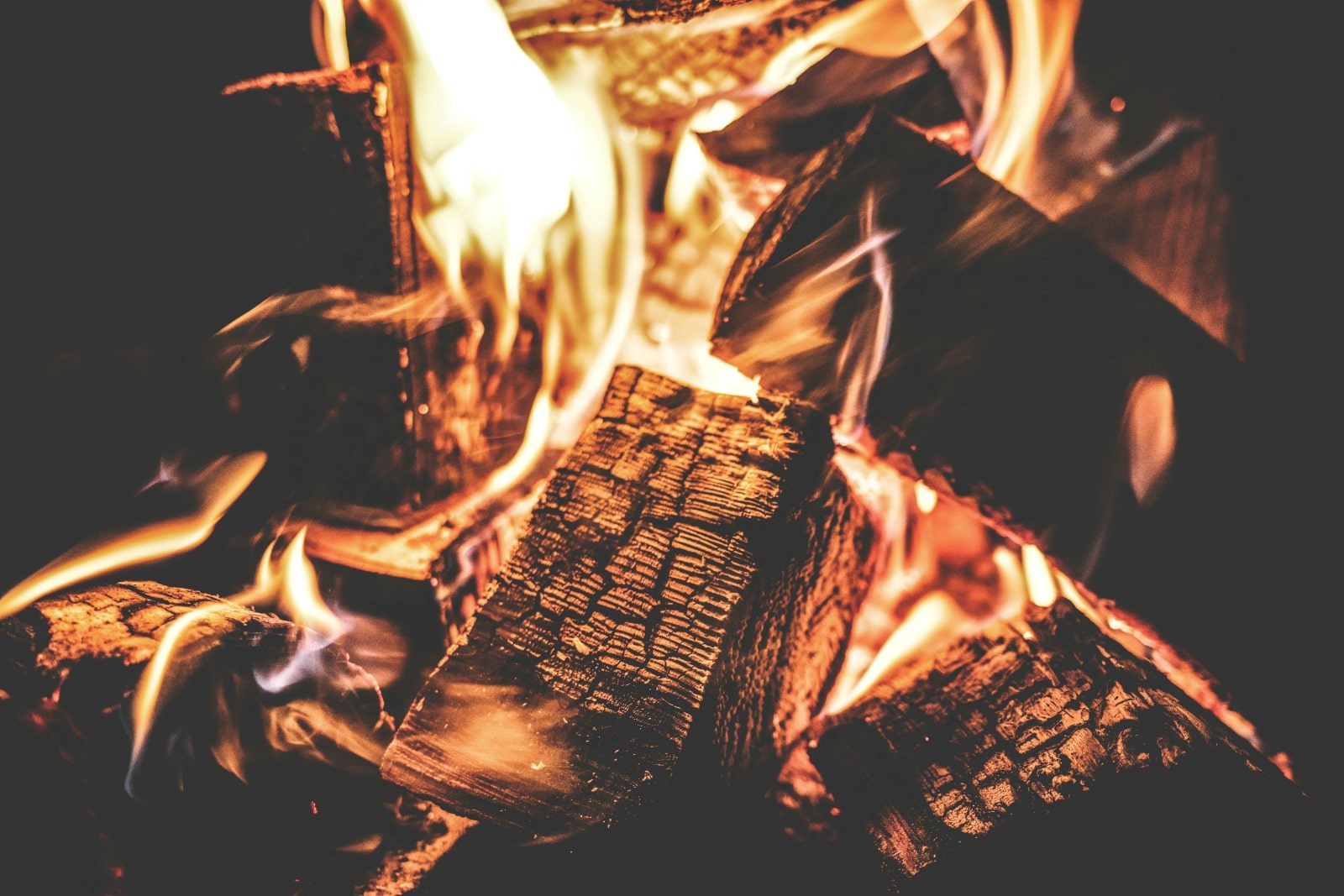
Camping in cold weather is more than a test of endurance; it’s an opportunity to connect with nature in its raw, tranquil form. By shifting your mindset and fully immersing yourself in the adventure, you can transform potential discomfort into a rewarding journey. Mastering how to stay warm camping isn’t just about gear and preparation—it’s also about embracing the beauty of the moment.
Appreciate the Unique Environment
Winter landscapes offer a serene beauty that’s unmatched by other seasons. Snow-covered trees, crisp air, and the quiet stillness create an environment that feels almost magical. Spend time observing the details around you, from the way frost sparkles in the morning light to the patterns created by animal tracks in the snow. These simple moments remind you why you chose to camp in such conditions.
Allow yourself to slow down and savor the experience. Whether it’s sipping hot cocoa by the fire or watching the stars from your sleeping bag, take time to enjoy the uniqueness of the season.
Connect with Your Group
If you’re camping with friends or family, cold-weather camping offers a chance to bond like no other experience. Sharing stories, preparing meals together, or working as a team to set up camp fosters a sense of camaraderie. Passing on tips about how to stay warm camping, like layering techniques or campfire tricks, can strengthen connections and create lasting memories.
Games, laughter, and shared accomplishments help keep spirits high, even when the temperature drops. If you’re camping solo, use the quiet to reflect or journal, making the experience equally enriching.
Embrace the Challenges
Cold-weather camping comes with its share of challenges, but overcoming them can be immensely satisfying. Whether it’s starting a fire in snowy conditions or staying comfortable during a frigid night, each obstacle you conquer builds resilience. These moments teach valuable lessons in adaptability and resourcefulness.
Instead of focusing on the hardships, view them as opportunities to test your skills and grow. Every moment you spend learning how to stay warm camping adds to your confidence and experience for future trips.
Make the Most of Small Comforts
Small comforts can significantly enhance your camping experience. Warm, hearty meals, cozy socks, or a favorite blanket can make all the difference in your mood and warmth. Even something as simple as sitting close to the fire with a cup of tea can feel luxurious in the cold.
Use these little rituals to bring joy to your adventure. Taking the time to appreciate these comforts helps create a positive atmosphere, making the cold weather more manageable and enjoyable.
Reflect on the Adventure
After braving the elements, take time to reflect on your experience. What did you learn? What moments stood out the most? Whether it’s the thrill of successfully staying warm or the satisfaction of adapting to the cold, reflecting helps you appreciate the journey and look forward to future camping adventures.
Cold-weather camping is as much about your mindset as it is about preparation. By focusing on the positives, embracing the challenges, and cherishing the moments of warmth, you can create an experience that’s as fulfilling as it is unforgettable.
FAQs About How To Stay Warm Camping
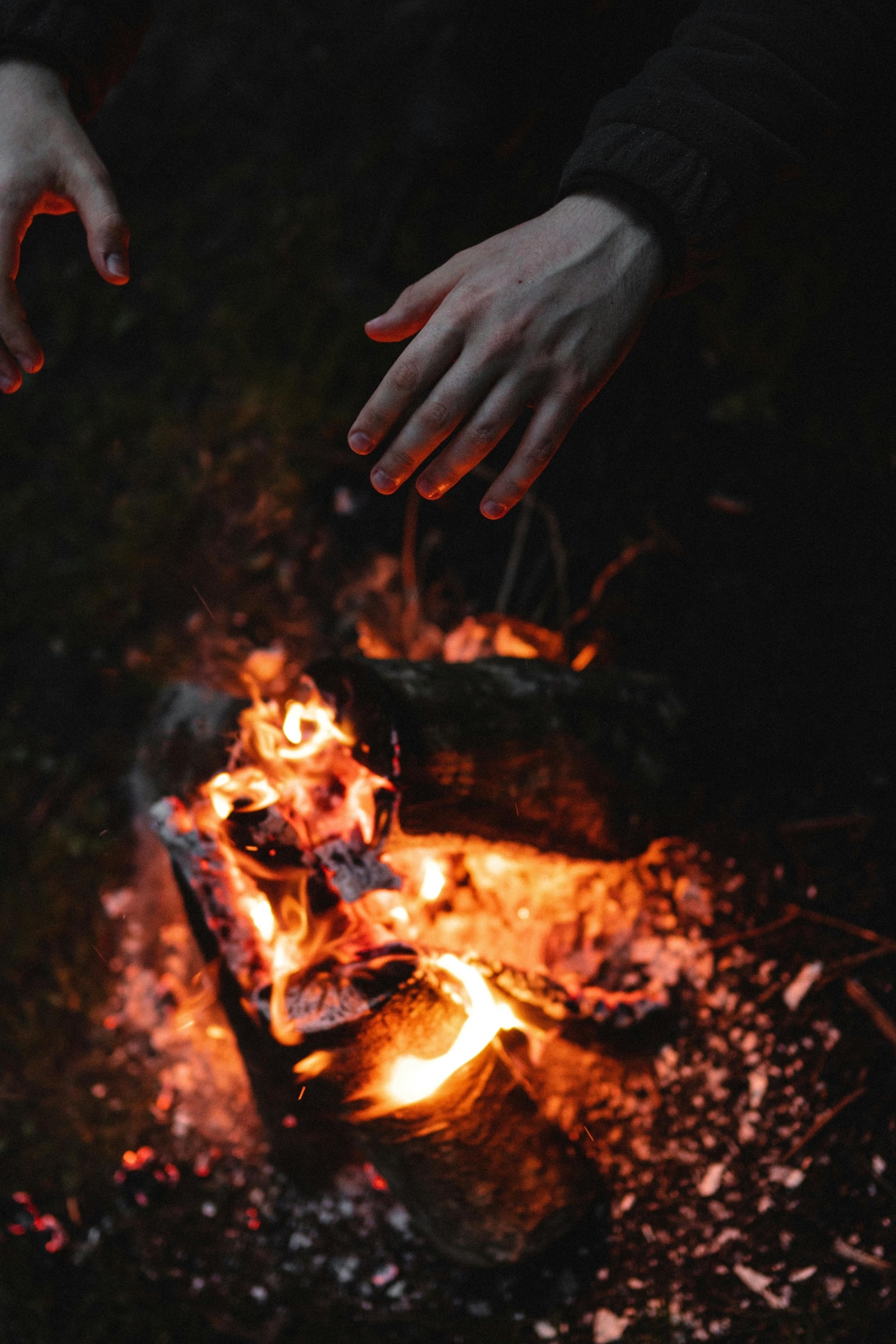
When camping in cold weather, staying warm is key to having a comfortable and enjoyable experience. Whether you’re new to winter camping or just looking for more ways to improve your warmth, these frequently asked questions will help guide you on how to stay warm camping.
1. What materials should I wear to stay warm camping?
For warmth, opt for wool, fleece, or synthetic materials. These fabrics retain heat while wicking moisture away from your skin. Avoid cotton, as it traps moisture and increases the risk of getting cold. Layering is essential to adjust your warmth as temperatures fluctuate.
2. How can I ensure warmth while sleeping in a tent?
To stay warm while sleeping, use a sleeping bag suited for the temperature, paired with an insulated sleeping pad. Adding extra blankets and wearing thermal clothing inside your sleeping bag will boost warmth. A hot water bottle can also provide extra heat throughout the night.
3. Should I dress in layers when camping in cold weather?
Yes, dressing in layers is the best way to manage warmth while camping. Start with a moisture-wicking base layer to keep sweat off your skin. Add an insulating mid-layer for warmth, and top with a waterproof, windproof outer layer to protect against the elements.
4. How do I prevent my tent from getting cold?
To keep your tent warm, set it up on insulated ground, like foam pads, and use reflective blankets or liners inside. Position the tent away from wind exposure and make sure there is ventilation to avoid condensation, which can make the interior feel colder.
5. Can specific foods help me stay warm camping?
Yes, calorie-dense foods like nuts, energy bars, or pasta help fuel your body and keep your metabolism active. Drinking warm beverages such as tea, soup, or hot chocolate also helps maintain core temperature and keeps you feeling warm during the day and night.
6. How can I stay warm while moving around?
Light physical activity helps you stay warm by boosting circulation. Try hiking, doing jumping jacks, or swinging your arms to keep the blood flowing. Be careful not to sweat, as moisture can cool you down quickly. Layer up for easy adjustment when needed.
7. What should I do if my feet get cold?
Keep feet warm by wearing insulated, waterproof boots and moisture-wicking socks. Change into dry socks before bed, and consider using foot warmers. Insulating your feet in your sleeping bag at night, or using a hot water bottle, will prevent heat loss and maintain comfort.
8. How do I keep my hands warm while camping?
Wear insulated gloves or mittens to protect your hands from the cold. Keep hand warmers in your pockets for quick heat, and make sure your gloves are waterproof. Regularly move your hands and arms to improve circulation and prevent stiffness and numbness from the cold.
9. Can I use a heater in my tent for warmth?
Only use a heater specifically designed for camping, and always follow safety instructions. Ensure your tent is properly ventilated to prevent carbon monoxide buildup. Never leave a heater unattended, and make sure it’s safely away from flammable materials, such as sleeping bags or tents.
10. What type of sleeping bag is best for cold-weather camping?
For cold-weather camping, choose a sleeping bag rated for temperatures lower than what you expect. Down sleeping bags offer excellent warmth but can lose their insulating properties when wet. Synthetic bags are more water-resistant and still provide warmth even if damp.
11. Should I avoid alcohol to stay warm camping?
Yes, alcohol can make you feel warmer temporarily but actually lowers your core body temperature. Instead of alcohol, drink warm beverages like herbal tea, hot chocolate, or soup. Staying hydrated and warm is critical for maintaining a comfortable body temperature during camping trips.
12. How can I keep my gear from freezing overnight?
Store critical gear, such as water bottles, in your tent or inside your sleeping bag to prevent freezing. Use insulated containers to keep water from turning to ice. You can also place your boots near the fire or inside your tent to keep them warm and functional.
13. How can I stay warm without a fire?
Staying warm without a fire is possible by using warm clothing, a good sleeping bag, and proper shelter. Invest in high-quality thermal layers, insulated pads, and sleeping bags rated for the temperatures you expect. Keep your tent well-ventilated but shielded from the wind.
14. Should I bring extra blankets to stay warm?
Yes, extra blankets provide additional insulation and warmth while sleeping. Wool or fleece blankets are great for trapping heat. You can also use a space blanket or emergency bivvy bag for an extra layer of warmth. These are especially helpful in colder conditions.
15. How do I prevent condensation inside the tent?
Condensation can make your tent feel colder. Prevent this by properly ventilating your tent through windows or vents. Avoid using a heater without ventilation. You can also use moisture-absorbing products like silica gel or dehumidifiers designed for camping to reduce the buildup of condensation.
16. Is it better to camp in a sheltered or open area?
A sheltered area is typically better for staying warm camping, as it protects you from wind and cold drafts. Look for natural windbreaks like trees, rocks, or hills. Camping in an open space increases exposure to wind, which can quickly strip away body heat.
17. What can I do to stay warm if I’m camping solo?
When camping solo, focus on personal warmth strategies. Use a well-insulated sleeping bag and wear layered clothing, including thermal underwear, hats, and socks. Regular physical activity, such as short walks or stretches, will help keep your circulation up and your body warm.
18. How often should I check my gear for warmth?
Check your gear before and during your trip to ensure everything is functioning properly. This includes checking your sleeping bag, tent, and clothing for signs of damage or wear. Make adjustments as necessary to ensure you stay warm camping, especially if temperatures drop unexpectedly.
19. How do I stay warm while cooking in cold weather?
Use a compact stove or portable heater to prepare meals, as cooking over an open fire can be tricky in windy, snowy conditions. Make sure to keep your cooking gear close by for warmth and use insulated containers to keep food and liquids hot for longer.
20. What other tricks help to stay warm camping?
Wrap a scarf around your neck to keep warm air trapped. Avoid sweating, as it can make you feel colder. If possible, keep your boots and gloves dry, and keep an emergency blanket handy. These small tricks add up to a more comfortable experience in cold weather.
Mastering how to stay warm camping is all about preparation, gear, and adaptability. By following these tips, you can stay warm and enjoy your camping experience, no matter how chilly the weather gets.
Amazon and the Amazon logo are trademarks of Amazon.com, Inc, or its affiliates.